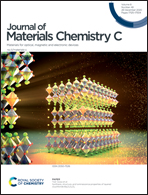Enhancing the red upconversion luminescence of hybrid porous microtubes via an in situ O-substituted reaction through heat treatment†
Abstract
Rare earth-doped upconversion (UC) micro/nanocrystals have important applications in varying fields including multilevel anti-counterfeiting, photonics, deep-tissue imaging, and therapeutics. However, one of the major hurdles is the weak luminescence associated with the constraints of conventional multi-peak emissions in achieving photoluminescence imaging with high spatial resolution and sensitivity. Herein, a technique for the heat treatment of a NaYF4 maternal lattice is presented for achieving porous one-dimensional NaYF4:Yb/Er@YOF:Yb/Er hybrid structures with excellent optical performance through in situ ion-exchange. In the course of detailed studies, an irreversible spatially confined recrystallization of maternal crystals to different phases is found, which preserves the crystal's original morphology and size. The enhanced single-band dark red luminescence emission has been achieved and the responding mechanisms are proposed based on the control of the UC path by phonon mediation. Particularly, these porous one-dimensional NaYF4:Yb/Er@YOF:Yb/Er hybrid structures have been used as potential security ink for writing, indicating immensely promising results for direct anti-counterfeiting applications. Our results demonstrate that the heat treatment technology opens the door for the synthesis of highly efficient single-band red phosphors with expanded applications.



 Please wait while we load your content...
Please wait while we load your content...